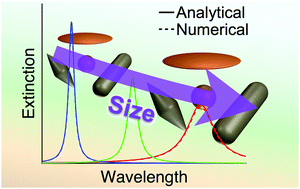Universal analytical modeling of plasmonic nanoparticles†
Abstract
Control over the optical response of metal nanoparticles and their associated plasmons is currently enabling many promising applications in areas as diverse as biosensing and photocatalysis. In this context, experiments based upon colloid synthesis and nanofabricated structures are assisted by numerical electromagnetic modeling, which supplies predictive simulations, but not the kind of physical intuition needed for exploration of new ideas, such as one finds when simple mathematical expressions can describe a problem. This tutorial review presents and extends a simple analytical simulation method that allows us to accurately describe the optical response of metal nanoparticles, including retardation effects, without the requirement of large computational resources. More precisely, plasmonic extinction spectra and near-field enhancement are described through a small set of real numbers for each nanoparticle shape, which we tabulate for a wide selection of common morphologies. Remarkably, these numbers are independent of size, composition and environment. We further present a compilation of nanoplasmonic experimental data that are excellently described by the simple mathematical expressions here introduced.



 Please wait while we load your content...
Please wait while we load your content...